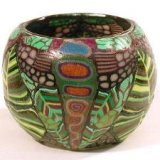EARTH
GUILD
33 Haywood Street
Asheville NC 28801
1-800-327-8448
828-255-7818
fax: 828-255-8593
inform@earthguild.com
Gallery

POLYMER CLAYS: Introduction
Polymer Clays are plastic modeling compounds that bake hard at household
oven temperatures. Unbaked, and properly stored at room temperature, they
stay soft and pliable indefinitely. They come in a great many colors.
Before they are baked, they can be shaped by hand, extruded, worked into
“canes”, even folded like fabric. Baked, they can be drilled, carved,
sanded, painted, glazed.
Do not use the same utensils for polymer clays and food preparation; wash
hands well after handling the clays. Brands may be mixed, with some experimenting,
since baking times and temperatures vary slightly. We carry Sculpey III®
and Fimo Soft®.
 |
Sculpey III in
2 oz packs Basic Polymer Clay Instructions are free with order –just ask. Or find them here. |
CANEWORKING, A SHORT DESCRIPTION
If you are around polymer clay much, you are bound to run into the term “caneworking”. It is a borrowed glasswork technique, best known in the Venetian “millefiori” trade beads. Polymer clay is vastly easier to handle than glass, and incredibly elaborate, detailed designs are possible.
Rods, or logs, or wedges, or sheets of clay in different colors are arranged so that when they are joined into a solid mass, their cross-section makes the desired design. Then thin wafers are sliced off, making many (possibly hundreds) almost identical copies of the design.
Canes are generally built much larger than the slices will ultimately be. They are then “reduced”, carefully rolled and patted till they are much smaller, distorting them as little as possible in the process. Slices can be made at any stage, yielding a range of sizes. They can be thick or thin, free-standing or stuck to a surface. Geometric patterns are easier, but flowers, faces, animals are all possible, with patience and ingenuity. See The New Clay (with polymer clay books), for much more detail.